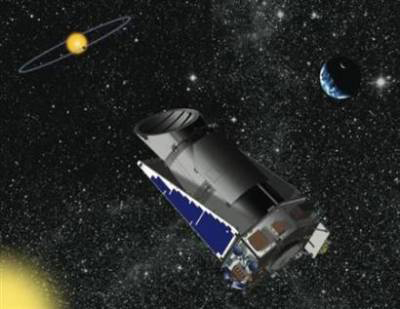America hunts the planet like Earth
A spacecraft of the US Aeronautics Agency (NASA) will be launched into the March 5 space, carrying a super large camera to search for planets capable of nurturing life in the galaxy.

The Kepler spacecraft carries the largest camera ever launched out of the world.Photo: Reuters.
Under the plan, the mission of the Kepler spacecraft is to search for stars like the sun and stars of the size or structure of the globe. It will be launched by Delta II missile at Cape Canaveral Air Force Base, Florida.
For years the scientific community wanted to find out if life existed somewhere in the universe or the earth was the only planet with life. 'Kepler will expand our understanding of the galaxy. Its findings can help people change basic concepts about ourselves , "said Jon Morse, director of NASA's astrophysics division.
Since 1995, astronomers have discovered that about 300 extrasolar planets are revolving around their own stars, but most of them are large planets formed from gas dust, making it difficult to nurture the living. Kepler's mission is to search for stone planets around a star. The distance between them is not too close (because everything on the planet will be burned by the heat from the star) but it is not too far (because then the ice will cover the planet's surface that makes life impossible) .
'We want to find planets that are not too hot and not too cold because life only appears on moderate temperature planets, where water occupies most of the surface area,' said William Borucki, an expert at NASA, said. He estimated that Kepler spacecraft could detect about 50 such planets.
'If Kepler finds that planet, then we can confirm that life exists in the galaxy. In the case that it detects a few planets of moderate temperature, we can conclude that planets capable of nourishing life as Earth are rare , 'he said.
Astronomer Debra Fischer of the University of San Francisco (USA), who hunted the planet like Earth for many years, said: 'Planets with favorable conditions for life can contain water, but they do not have geological tectonic plates so that the soil can rise above the water surface. Their oceans can also contain many living things like the earth's oceans, but these creatures are not qualified to contact us. '
In some star systems, planets move in front of stars if we look from the globe. The telescope on Kepler, with the largest camera ever launched into space, has the ability to detect the faint light of distant stars and planets that pass in front of them.
- The most Earth-like planet shows up
- Your planet is closest to Earth
- What new planet is '2nd Earth'?
- Information about 'Second Earth'
- 2 copies of Earth crashed into each other, shooting debris across space
- Exotic planet like most earth ever
- Discovering the planet is very similar to the earth
- NASA claims Proxima b Earth-like planet b does not support life
- The top 5 most Earth-like planets have been discovered
- Discovering the planet can survive life
- The discovery of a rock planet is very similar to the globe
- Found a planet that can replace Earth?
 Van Allen's belt and evidence that the Apollo 11 mission to the Moon was myth
Van Allen's belt and evidence that the Apollo 11 mission to the Moon was myth The levels of civilization in the universe (Kardashev scale)
The levels of civilization in the universe (Kardashev scale) Today Mars, the sun and the Earth are aligned
Today Mars, the sun and the Earth are aligned The Amazon owner announced a secret plan to build a space base for thousands of people
The Amazon owner announced a secret plan to build a space base for thousands of people